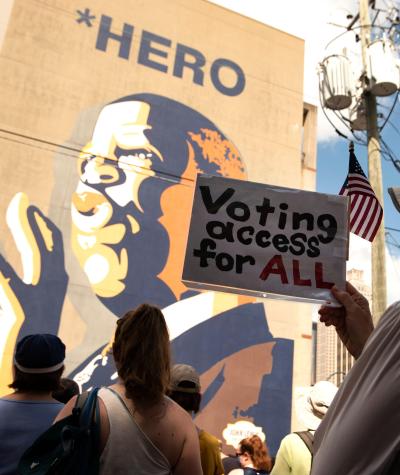Nearly 60 years ago, Congress enacted the Voting Rights Act (VRA) to prohibit racial discrimination in voting and ensure all voters can have an equal voice in our elections.
Unfortunately, in recent years, the Supreme Court has gutted the VRA and drastically weakened its once-successful protections for Black and brown voters—a situation Congress has repeatedly failed to fix despite having the ability do so.
Today, Congress gets another chance. Members of the U.S. House, led by Representative Terri Sewell, have reintroduced the John Lewis Voting Rights Advancement Act (VRAA), legislation named after the late civil rights icon that would help right the wrongs of the Supreme Court’s harmful decisions by restoring the full strength of the VRA.
Most prominently, the VRAA would reestablish a system known as “preclearance,” which was originally created in Section 5 of the VRA to require that states and localities with a history of racial discrimination get changes to their voting laws approved by the federal government before they can go into effect.
In the 2013 case of Shelby County v. Holder, the Supreme Court effectively gutted Section 5’s preclearance requirement, allowing jurisdictions across the country to implement new discriminatory practices such as restrictive voter ID laws, polling place closures and purges of voters from registration rolls—all of which make it disproportionally harder for Black and brown voters to cast their ballots.
The VRAA would revitalize preclearance protections for Black and brown voters, as well as establish a nationwide system of preclearance for certain changes to voting practices that have consistently proven discriminatory.
This would mean that any change to election laws or polling place locations in certain jurisdictions would need to be reviewed by the DOJ or a federal court first, ensuring that Black and brown voters won’t have their voices silenced by sudden discriminatory changes.
The VRAA would also strengthen Section 2 of the original VRA, another core component of the law that empowers voters to bring legal challenges against election rules that discriminate against voters based on their race or the color of their skin.
While Section 5 of the VRA is designed to block anti-voter laws before they go into effect, Section 2 gives voters the opportunity to sue for relief after they have been discriminated against. Together, they tackle racial discrimination in voting from both ends.
Despite the Supreme Court’s recent ruling in Allen v Milligan, which reaffirmed the validity of Section 2, the current Supreme Court has a poor track record on democracy issues and has weakened the VRA multiple times.
The VRAA would address these concerns by codifying well-established standards for evaluating VRA lawsuits and provide new protections against changes to voting laws that are more discriminatory than the rules they replaced. This would ensure that Black and brown voters will be able to vote under fair maps and with fair rules.
Free and fair elections rely on every voter having the ability to make their voice heard. The original VRA has helped our country make great strides towards the promise of a democracy that works for all.
But the time is long past to fully eliminate racial discrimination at the ballot box. The John Lewis Voting Rights Advancement act is sorely needed to ensure every voter is truly able to make their voice heard.
